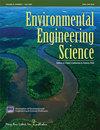Atenolol Biotransformation by Denitrifying Mixed Culture Communities
IF 1.8
4区 环境科学与生态学
Q4 ENGINEERING, ENVIRONMENTAL
引用次数: 0
Abstract
The biotransformation of atenolol, sotalol, and metoprolol by mixed culture denitrifying communities was examined as a function of carbon availability and pharmaceutical concentration to explore the possible roles of cometabolism and direct substrate utilization. Sotalol and metoprolol were not found to be transformed. A matrix of conditions explored the biotransformation of water resource recovery facility relevant (25 μg/L) and chemical oxygen demand (COD)-equivalent (10–100 mg/L) atenolol concentrations in batch reactors (1 L) containing 25 mg-N/L nitrate. Carbon (MicroC® 2000) conditions included Nonlimiting (COD:N ratio >10), Partially Limiting (COD:N ratio = 2–3), and Limiting (COD:N ratio <1). Reactors without atenolol served as denitrification control experiments. Results suggest that atenolol did not appreciably influence nitrate reduction. The extent of atenolol degradation was independent of carbon availability. In the experiments conducted in the μg/L range, 30–40% biotransformation was observed. Scant degradation at higher concentrations suggested that direct utilization of the pharmaceutical was either unlikely or occurring slowly and independent of the pharmaceutical concentration. Process-based modeling using the Activated Sludge Model framework assessed denitrification across carbon availability conditions and incorporated three individual pharmaceutical biotransformation modeling strategies: (1) direct metabolism model; (2) cometabolic model, and (3) biotransformation kinetic model. Results suggest that there was insufficient evidence to suspect direct metabolism meaningfully contributed to the reduction in atenolol concentration. The cometabolic process-based model, including both growth and nongrowth-linked rate coefficients offered the best model performance, although growth-linked cometabolism was limited and not readily apparent across all experiments (growth-linked transformation coefficient <0.4 g-atenolol·g-COD−1). Thus, the biotransformation kinetic model is favored for monitoring and forecasting biotransformation in larger-scale systems because use of the parsimonious model (rate coefficient of 7 mg-atenolol·g-COD−1·d−1) resulted in only modest performance reductions. The biotransformation model represents an improvement over pseudo first-order models as it is a mixed-order kinetic model that is linked to transient biomass conditions.反硝化混合培养群落对阿替洛尔的生物转化
研究了混合培养反硝化菌群对阿替洛尔、索他洛尔和美托洛尔的生物转化与碳有效性和药物浓度的关系,以探讨共同代谢和直接底物利用的可能作用。索他洛尔和美托洛尔未发现转化。通过条件矩阵探讨了在含25 mg- n /L硝酸盐的间歇式反应器(1 L)中,水资源回收设施相关浓度(25 μg/L)和化学需氧量(COD)当量(10-100 mg/L)阿替洛尔的生物转化。碳(MicroC®2000)条件包括非限制性(COD:N比>10),部分限制性(COD:N比= 2-3)和限制性(COD:N比<1)。无阿替洛尔反应器作为反硝化控制实验。结果表明,阿替洛尔对硝酸盐还原没有明显影响。阿替洛尔的降解程度与碳有效性无关。在μg/L范围内进行的实验中,观察到30-40%的生物转化。在较高浓度下很少降解表明药物的直接利用不太可能或发生缓慢且独立于药物浓度。使用活性污泥模型框架的基于过程的建模评估了碳可用性条件下的反硝化作用,并结合了三种单独的药物生物转化建模策略:(1)直接代谢模型;(2)生物代谢模型;(3)生物转化动力学模型。结果表明,没有足够的证据怀疑直接代谢对阿替洛尔浓度的降低有意义。基于生长和非生长相关速率系数的共代谢过程模型提供了最佳的模型性能,尽管生长相关的共代谢是有限的,并且在所有实验中都不明显(生长相关转化系数<0.4 g-阿替洛尔·g-COD−1)。因此,生物转化动力学模型更适合于监测和预测大型系统中的生物转化,因为使用简约模型(速率系数为7 mg-阿替洛尔·g-COD - 1·d - 1)只会导致适度的性能降低。生物转化模型代表了对伪一阶模型的改进,因为它是一个与瞬态生物量条件相关的混合阶动力学模型。
本文章由计算机程序翻译,如有差异,请以英文原文为准。
求助全文
约1分钟内获得全文
求助全文
来源期刊

Environmental Engineering Science
环境科学-工程:环境
CiteScore
3.90
自引率
5.60%
发文量
67
审稿时长
4.9 months
期刊介绍:
Environmental Engineering Science explores innovative solutions to problems in air, water, and land contamination and waste disposal, with coverage of climate change, environmental risk assessment and management, green technologies, sustainability, and environmental policy. Published monthly online, the Journal features applications of environmental engineering and scientific discoveries, policy issues, environmental economics, and sustainable development.
 求助内容:
求助内容: 应助结果提醒方式:
应助结果提醒方式:


